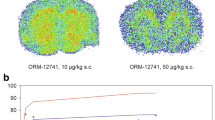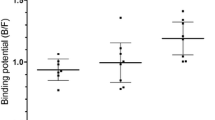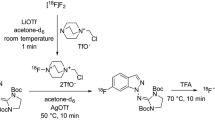Abstract.
Rationale: s-Fluorocarazolol [(S)-FCZ] is the major positron emission tomography (PET) ligand currently used to visualize central β-adrenergic receptors in vivo, although its pharmacology is incompletely known. Objective: Our objective was to comprehensively characterize the in vitro pharmacology of (S)- and (R)-FCZ to determine its suitability for study of central and peripheral β-adrenergic receptors. Methods: We characterized the in vitro pharmacology of (S)-FCZ at 42 biogenic amine receptors and transporters in vitro using the resources of the National Institute of Mental Health Psychoactive Drug Screening Program. Results: As expected (R)- and (S)-FCZ had high affinities for β-adrenergic receptors (Ki values=0.08–0.45 nM) and negligible affinities (Ki values>100 nM) for nearly all other tested receptors and transporters with the exception of the h5-HT1A receptor for which (S)-FCZ had high affinity (Ki=34 nM). Interestingly, (R)-FCZ had low affinity for the h5-HT1A receptor (Ki=342 nM). Conclusion: The high affinity of (S)-FCZ for the h5-HT1A receptor is not likely to interfere with studies of peripheral β-adrenergic receptors, since 5-HT1A receptors are expressed at very low levels outside the central nervous system. Indeed, computer simulations predict that even at low ligand concentrations, 5-HT1A binding in brain regions like hippocampus are likely to be substantial. Thus, (S)-FCZ may not be a suitable PET ligand for studies of central nervous system β-adrenergic receptors unless the contribution by 5-HT1A sites can be shown to be negligible.
Similar content being viewed by others
Author information
Authors and Affiliations
Additional information
Electronic Publication
Rights and permissions
About this article
Cite this article
Roth, B.L., Ernsberger, P., Steinberg, S. et al. The in vitro pharmacology of the β-adrenergic receptor pet ligand (s)-fluorocarazolol reveals high affinity for cloned β-adrenergic receptors and moderate affinity for the human 5-HT1A receptor. Psychopharmacology 157, 111–114 (2001). https://doi.org/10.1007/s002130100844
Received:
Accepted:
Issue Date:
DOI: https://doi.org/10.1007/s002130100844




